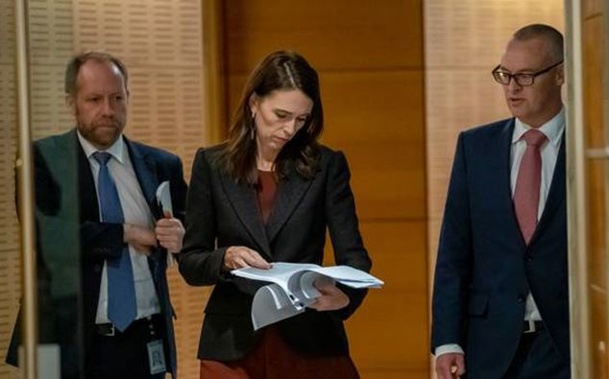
Hundreds of background documents relating to the Government's response to the Covid-19 pandemic have been released this morning.
The "document dump" includes new information on measures at the border, the wage subsidy and the health response.
Govt planned for 16,000 people to flock to NZ, fleet of motorhomes sat unused
The Government prepared hundreds of motorhomes to help house an anticipated 16,000 people returning to New Zealand in part because help from commercial providers was not forthcoming.
A Cabinet paper from April 23, released proactively today among thousands of documents about the Covid response, discussed making $10 million available for temporary accommodation for health and disability workers who needed to self-isolate but for various reasons couldn't do so in their homes.
Those reasons included if someone in their home had Covid-19 or was self-isolating, or if they lived with a vulnerable person.
The Government also expected huge housing demand as Kiwis returning from overseas had to be placed in quarantine or managed isolation facilities.
"During the early stage of New Zealand's Covid-19 response, commercial accommodation providers were reluctant to accommodate people needing to quarantine or self-isolate.
"The self-contained and mobile nature of motorhomes made them a good alternative option," the paper said.
"The initial predictions of the number of people requiring temporary accommodation were also extremely high, at around 16,000. This was largely due to the number of people booked on flights to return to New Zealand over a short period of time."
Almost 600 motorhomes were made available in Auckland, Christchurch and Queenstown, including 305 at Auckland's ASB Showgrounds, 250 at the A&P Showgrounds in Christchurch, and 44 in the Wellington Top 10 Holiday Park.
But the expected demand did not transpire.
The $10m was approved and announced on May 12.
The paper notes that 302 households have been placed into temporary accommodation by April 19, at a cost of just over $1m, with a further 99 in the process of being placed.
Most of the placed people lived in New Zealand, but 19 other countries were also referenced as the place of their "affected homes" including Australia, the UK and Germany.
Thirty-five people were in temporary accommodation after leaving quarantine or managed isolation.
Treasury warning over $60b scheme
The Treasury warned Finance Minister Grant Robertson about the "significant downside risks" of the Reserve Bank's historic $60 billion money-printing programme.
This could included a bill to the taxpayers' of more than $2 billion - but could also result in a profit.
A paper from the Treasury, dated May 6 and released today, detailed the options and potential outcomes of the Reserve Bank's role in New Zealand's economic recovery.
The paper noted that the central bank has already reduced the official cash rate (OCR) to 0.25 per cent - and had no intention to go any lower.
Instead, to help stimulate the economy, the Reserve Bank would buy tens of billions of dollars' worth of central and local government bonds.
In total, the Reserve Bank will buy $60b worth of bonds – this process is called "quantitative easing".
But the Treasury advised Robertson that the scheme could be problematic.
"There is significant uncertainty about the returns on [the quantitative easing programme] and therefore about the gains or losses likely to be charged against the indemnity," the paper said.
"It is plausible that the [quantitative easing programme] will return a net gain. However, there are significant downside risks."
That downside risks was the loss of billions of dollars.
"The Bank's best estimate of large but plausible interest rate losses arising from the programme is a net loss of $2.3 billion."
The Treasury also warned that the programme could also add "a few billion dollars" more to the Government's expected $200b debt pool.
$27m for road repairs
Cabinet agreed to urgently reallocate $27m from the Provincial Growth Fund (PGF) for work to be done on local roading projects across the country.
It was party of the Government's push to change the focus of the fund to a Covid-19 relief programme before it finished allocating its $3b before the election.
When it was clear Covid-19 would have a severe impact on the economy, $1.2b was redirected to Covid projects which would stimulate the economy.
Documents released today show that $27.2m was urgently allocated to fixing road projects across the country.
Some $12.5m was earmarked for roads in the Bay of Plenty – it's the region that got the most money by far.
Whanganui-Manawatu got $5.5m and the West Coast got just under $2m.
The West Coast, Wairarapa, Taranaki, top of the South and Waikato all got under $3m.
Help for essential workers
Essential workers were allowed to temporarily "pause" their parental leave for a maximum of three months in order to return to work in response to Covid-19.
Under the rigid rules of the Parental Leave and Employment Protection Act 1987, if someone on parental leave goes back to work their payments stop.
But because of the "unprecedented demand" on some essential services under lockdown,
Cabinet agreed on April 16 to a proposal by Minister for Workplace Relations and Safety
Iain Lees-Galloway to allow the temporary pause.
The proposal was a high-trust model and required the person to contact Inland Revenue and would be permitted to return to work if:
- their skill could not be filled by another person within the timeframe, and/or
- there was a higher demand than usual for workers in their role due to the circumstances of Covid-19 and they returned to work to reduce staff shortages.
Pausing and un-pausing parental leave wouldn't have an additional cost to the Crown as the maximum number of payments would be changed.
It would also remove a barrier for women to participate in essential work, the advice said.
Govt considered $150m loan for NZ Post
The Government considered providing embattled NZ Post with a $150m loan to help it stay afloat but instead decided to provide it with a bailout.
Advice to Cabinet from Treasury, released this morning as part of the Government's Covid-19 document dump, reveals the detailed decision making bending saving Government-owned NZ Post.
It noted Covid-19 would have a "serious effect" on the state-owned enterprises' viability at a time when New Zealanders needed a postal service more than ever.
Cabinet agreed to a $280m bailout of NZ Post – $130m from Budget 2020 while an equity injection of $150m would come from the Government's Covid Response and Recovery Fund.
But a paper released today reveals that one option was to provide a loan.
According to officials, a loan would incentivise NZ Post to only spend what was required.
This loan scheme would have been similar to the one the Government embarked on with Air NZ, whereby it loaned the company $900m.
The Government had the option of converting that loan into equity – meaning the Government would simply own more of the company.
But, instead, Cabinet agreed to the bail out after Treasury's recommendation.
"An equity injection from the Crown, as owner of NZ Post, is a simple solution that is easy to implement immediately by shareholder resolution."
Any left over money would have to be returned to the Government – this would be enforced by the minister on charge of NZ Post, Shane Jones.
Early education commitment meant millions spent
Education Minister Chris Hipkins went against official advice - choosing to potentially spend millions more on early childhood education's COVID-19 support.
Closures at alert level four meant services lost their Childcare Subsidy.
In an April report, officials recommended spending more than $8.7 million on one-off grants - to get providers through level four and two weeks after.
But Hipkins committed to funding for as long as the country remained at level three - which would cost another $1.9 million dollars every extra week.
Officials also warned reopened services could receive both the subsidy and grant money.
13 actives cases in NZ
As of yesterday, there were 13 active cases of Covid-19 in New Zealand, all of them in managed isolation or quarantine.
Three new cases of the virus were announced yesterday - one in Rotorua and two in Christchurch.
Of the 1519 people who contracted the virus in New Zealand, 1484 have recovered.
Take your Radio, Podcasts and Music with you









